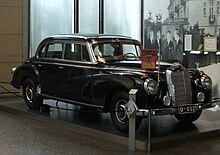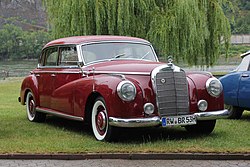Mercedes-Benz W 186
| Mercedes Benz | |
|---|---|
|
Mercedes-Benz 300 (1953)
|
|
| W 186 | |
| Sales designation: | Mercedes 300 |
| Production period: | 12 / 1951-8 / 1957 |
| Class : | Upper class |
| Body versions : | Limousine , cabriolet |
| Engines: |
Petrol engines : 3.0 liters (85–92 kW) |
| Length: | 4950-5065 mm |
| Width: | 1840 mm |
| Height: | 1600-1640 mm |
| Wheelbase : | 3050 mm |
| Empty weight : | 1780-1950 kg |
| Previous model | Mercedes-Benz W 159 |
| successor | Mercedes-Benz W 189 |


The series Mercedes-Benz W 186 the brand Mercedes-Benz is generally under the sales designation Mercedes-Benz 300 known. The Daimler-Benz AG presented its new car in the luxury class with six-cylinder - inline engine in April 1951 the 34th International Motor Show in Frankfurt before. The two-door Mercedes-Benz 300 S ( W 188 ) derived from it followed in October 1951 at the Salon de l'Automobile in Paris . The W 186 type was replaced in 1957 by the improved W 189 with largely the same body.
The Mercedes-Benz 300 was next to the smaller Mercedes-Benz 220 ( W 187 ), the first German representation sedan after the Second World War . The initially 115 hp Mercedes 300 was together with the 35 hp 300 S and the Porsche 356 1500 S (70 hp) the fastest production vehicle in German production. After the first German Chancellor Konrad Adenauer decided to use this vehicle as a company car, the name “Adenauer-Mercedes” became established for the W 186-300. In addition to this type, there were other 300 Mercedes such as the W 188 or the well-known 300 SL "Gullwing" ( W 198 ).
Until the introduction of the Mercedes-Benz 600 ( W 100 ) in 1964, the W 186 or its successor W 189 was “the” German state limousine, which was also used by some heads of state from other countries. Many a prominent personality also owned a Mercedes-Benz 300.
Types
There were types 300 (W 186 II), 300 b (W 186 III) and 300 c (W 186 IV) one after the other.
Type 300
The Mercedes 300, introduced in November 1951, had the design features of the W 159, which, due to the war, did not get beyond the prototype stage. The X-shaped oval tube frame already used in the Mercedes 230 was also used here. The body mounted on the chassis with a wheelbase of 3050 mm took up the design elements of the W 159 in a modernized form. The 300 was powered by a 3-liter six-cylinder engine with 85 kW (115 hp) and two carburetors. The design of this engine also went back to the pre-war M 159 unit , a construction with a displacement of 2.6 liters and overhead valves ( OHV valve control ). In the 300 model, in addition to the increase in displacement, the camshaft was relocated to the cylinder head ( OHC valve control ). The power was transmitted by a fully synchronized four-speed gearbox, with which a top speed of around 160 km / h was reached, an impressive figure at the time.
The chassis conceptually corresponded to the 170 S and 220 types , but was tailored to the higher weight and performance of the 300. When the vehicle was heavily loaded, the electrically switchable torsion bar suspension ensured that the rear wheels were leveled. A sunroof or folding roof was also available. A special technical feature of the entire 300 series was the central lubrication, which made the grease nipples still common at the time superfluous. What otherwise required a visit to the workshop could now be done by the driver without stopping by stepping on a stamp on the top left next to the pedals. A white indicator light that lights up every 100 km reminded the driver to carry out this process, which is necessary for operational safety, on a regular basis.
Type 300 b
In March 1954 the vehicle was revised. The brakes were wider brake shoes and then as Bremshelf designated brake booster improved. This made the Mercedes 300 b, along with the 300 SL, the first car with a brake booster. The engine output was increased to 92 kW (125 PS), and the 300 b also had vent windows at the front. Other design features were the chrome-plated protective fittings on the rear fenders and bumper horns at the front and rear.
Type 300 c
In a further revision in November 1955, the rear window was enlarged. In addition, wider tires were used. Another technical innovation is the so-called single-joint pendulum axle . The 300 c was also available for the first time with automatic for an additional charge of DM 1500 . It was built as a sedan with a base price of DM 22,000 and as a Cabriolet D with a base price of DM 24,700. Cabriolet D means that the vehicle has four doors with associated four side windows. There is room for five to six people. The steering wheel gearshift (later also the selector lever for the automatic transmission) allows up to three people to sit in front.
In November 1957, the slightly larger and more powerful 300 d ( W 189 ) replaced the 300 c.
data sheet
| Mercedes 300 | 300 b | 300 c | |
|---|---|---|---|
| Engine type | Mercedes-Benz M 186 | ||
| Engine type | Six-cylinder - inline engine ( four-stroke - gasoline engine ) | ||
| Bore × stroke | 85 mm × 88 mm | ||
| Displacement | 2996 cc | ||
| Compression ratio | 6.4: 1 | 7.4: 1 to 7.5: 1 | |
| power | 85 kW (115 PS) | 92 kW (125 PS) | |
| Torque | 195 Nm at 2500 rpm |
221 Nm at 2600 rpm |
|
| Gearbox (standard) | 4-speed manual transmission | ||
| drive | Rear wheel drive | ||
| Acceleration, 0–100 km / h in s |
18th | 17th | |
| Top speed, km / h |
160 | ||
| Fuel consumption (combined in l / 100 km) |
13.8 | 12.5 | |
Construction times and quantities
- Type 300 (W 186 II): 12 / 1951-3 / 1954; 4776 sedans, 2 chassis, 466 convertibles
- Type 300 b (W 186 III): 3 / 1954-7 / 1955; 1426 sedans, 125 convertibles
- Type 300 c (W 186 IV): 9 / 1955-8 / 1957; 1432 sedans, 51 convertibles
literature
- The new Mercedes-Benz types 300 and 300 S in: Motor vehicle technology 4/1952, pp. 121–123
Web links
Individual evidence
- ↑ Mercedes 300 / Adenauer. Auto image , accessed April 17, 2014 .
- ^ Wolfram Nickel: State coach for statesmen. RP Online , December 17, 2011, accessed April 17, 2014 .
- ↑ Buying A Mercedes Benz 300. beverlyhillscarclub.com, accessed January 30, 2017 .
- ↑ Type compass Mercedes-Benz passenger cars 1945–1975 , Motorbuch Verlag Stuttgart, 1st edition 2000, ISBN 3-613-02019-X
| Vehicle class | 1920s | 1930s | 1940s | ||||||||||||||||
| 6th | 7th | 8th | 9 | 0 | 1 | 2 | 3 | 4th | 5 | 6th | 7th | 8th | 9 | 0 | 1 | 2 | 3 | 4th | |
| Compact class | W 15 (type 170) | ||||||||||||||||||
| W 23 (type 130) | |||||||||||||||||||
| W 30 (type 150) | |||||||||||||||||||
| W 28 (type 170 H) | |||||||||||||||||||
| Middle class | W 02 (type Stuttgart 200) | W 136 / W 149 (types 170 V / 200 V) | |||||||||||||||||
| W 11 (type Stuttgart 260) | W 143 (type 230 n) | ||||||||||||||||||
| W 21 (type 200/230) | W 153 (type 230) | ||||||||||||||||||
| W 138 (type 260 D) | |||||||||||||||||||
| upper middle class | W 03 / W 04 / W 05 (types 300/320/350) | W 18 (type 290) | |||||||||||||||||
| W 10 / W 19 (types 350/370/380) | W 142 (type 320) | ||||||||||||||||||
| W 22 | |||||||||||||||||||
| Upper class | Type 400 & Type 630 | W 24 / W 29 / W 129 (types 500 K / 540 K / 580 K) | |||||||||||||||||
| W 08 (type Nürburg 460/460 K / 500 / type 500 N) | |||||||||||||||||||
| W 07 / W 150 (types 770/770 K) | |||||||||||||||||||
| Sports car | Model K | ||||||||||||||||||
| W 06 (type S / SS / SSK / SSKL) | W 24 / W 29 / W 129 | ||||||||||||||||||
| Off-road vehicle | W 103 (type G1) | W 31 (type G4) | |||||||||||||||||
| W 133 III (type 170 VG) / W 139 (type 170 VL) / W 152 (type G5) | |||||||||||||||||||
| Vans | L 3/4 | L 1000 Express | L 301 | ||||||||||||||||
| L 300 | |||||||||||||||||||

